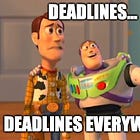Wes Kao - When to disagree and commit
👋 Hey, it’s Wes. Welcome to my weekly newsletter where I share frameworks for becoming a sharper operator, based on 15+ years as a marketer, builder, and a16z-backed founder. Read time: 5 minutes ⛑️ Some exciting news: I’m opening up spots for a handful of advisory consulting/executive coaching and keynote speeches. This is an opportunity to (a) work with me 1:1 as a personal advisor and sparring partner, or (b) have me speak with your team about standing out as a high-performer and building hype for your ideas. In the past month, I’ve spoken to teams at Grammarly, Panobi, Section, etc. Drop me a line at wes (at) weskao (dot) com and I’m happy to share more.
My co-founder has said one of the things he appreciated most about me was my ability to disagree and commit. I would fight for my point of view, hard. But once we made a decision, I brought the same advocacy for that decision to get our team excited about it, as if it were my idea all along. The ability to disagree and commit is especially important in situations where there’s no obvious answer for what to do. One way to build conviction is through conversation, discussion, and debate. Building on each other’s arguments, poking holes, and thinking rigorously to understand the situation as clearly as possible. Debating only works if you can fight well and enjoy working together after a debate. And at some point, every debate must come to an end. So when should you keep fighting? When should you disagree and commit? Great operators do both, but it’s not always clear when to take each path. Here are questions I ask myself to decide. 1. Have you made as strong of a business case as you could make?This is the most important consideration. If I don’t think I’ve explained myself well, I take responsibility if my audience isn’t persuaded. I need to feel confident that I’ve pitched my idea the best I possibly could before disagreeing and committing. This doesn’t mean talking louder and more forcefully, but rather, it means sharing your rationale. It means bringing evidence, examples, unique insights, logic, story, etc to illustrate your argument. It means sharing why you think an idea could work or not work. Do you think folks are missing something? Do you think they're taking the wrong interpretation? Share why. It takes confidence to make a business case. For me, this confidence is rooted in having a strong logical argument, and weaving data points into a compelling story to help others see what I see. If I made as strong of a case as I could and don’t have any regrets, I’m more likely to disagree and commit. 2. Do you believe the other party understands what you’re saying?If the answer is no, then I may keep attempting to explain. I owe it to my idea for them to understand it, in order to give an informed “no.” Otherwise, what are they even saying no to? If the answer is “yes they understand what I’m saying, but they still disagree,” I’m more likely to disagree and commit. You might think, “Well if they TRULY understood, they would come to the same conclusion as me.” But that’s not true. People have different values, priorities, worldviews, and philosophies on what “good” and “bad” look like. Ten different marketers could look at the same primary data, and come up with different interpretations of what this means and what to do about it. Ten different CEOs might deal with an incident and range from “This is unacceptable, let’s take action immediately” to “This isn’t great, so let’s keep an eye on it.” People can understand you AND still disagree with you. 3. Have you addressed counterpoints?Blind persistence doesn’t work. I’ve seen operators think they’re being tenacious by bringing up their idea over and over without addressing counterpoints. This is awkward because it shows you can’t read the room and folks don’t know how to get through to you. If you refuse to iterate and act on useful feedback, you don’t give your recipient anything to work with to reconsider your idea. Einstein said insanity is doing the same thing but expecting different results. Don’t only repeat yourself—try to address the question-behind-the-question and thoughtful counterpoints you might not have thought of. Remember: Your goal isn’t to get buy-in at any cost. Your goal is always to make the best decision for the organization. It’s possible your idea doesn’t meet the threshold for moving forward. That’s okay. When you remove your ego from the debate, you can see the process for what it is: An opportunity to sharpen your thinking, spar with smart people, and improve your insights/recommendations, regardless of the final outcome. 4. How high are the stakes?If I think a certain path would ruin the company, I’m going to keep fighting for my point of view. I feel a moral responsibility to prevent a train wreck. Even if the downside isn’t quite as dramatic, the bigger the decision, the more your team should fully understand all sides of the argument before proceeding. To fight your best fight, you’ll need to share what’s leading you to believe what you believe. Share your assumptions explicitly. Lay out your assertions. Showing your thought process allows folks to point out specific areas they agree or disagree with. This leads to an overall more nuanced conversation. If it’s not an expensive one-way door decision, and I believe the other recommendations on the table are decent, I’m more likely to go along with them. I might still “disagree” in the sense that I think my approach is better, but at that point, the cost of going with another (good) idea feels lower. 5. Do you think the alternatives could work?With strategy decisions, there’s often not a clear right answer. If an idea is obviously great, you’d do it. If it’s obviously terrible (or worse than other options), you’d abandon it. The problem is most of the time, you’re in grey territory. If it were obvious, we wouldn’t be debating—we would already have made the decision and moved on. It’s through the process of rigorous discussion that you pressure test your own and each other’s thinking. After hearing my colleagues’ arguments, and duking it out back and forth, I’m often convinced that their POV makes more sense than mine. This happens all the time, and it’s amazing. It means I’m working with sharp people who raise the average of our team. At a certain point, I might realize, “Hmm I’m no longer disagreeing. I’m actually agreeing and committing.” It takes humility, intellectual honesty, and maturity to recognize when someone else’s idea is better than yours. I was going to say “admit,” but that feels like you failed and have to accept defeat. “Recognize” is more accurate because as a leader, your job is to identify right ideas and put resources toward those ideas, regardless of where the idea originated. By the way, I say “their ideas” and “my ideas” to make it simpler, but it doesn’t matter who came up with an idea—as long as the end result is you’re doing what’s best for the business. Per the latter part of “disagree and commit,” the committing part isn’t a lukewarm resignation that you “lost” and now you have to go along grudgingly with a decision. The commit means committing as if the idea were your own to begin with. It means fully immersing yourself in this new idea, and advocating with the same life force and creativity you previously mustered trying to convince people of your idea. At the end of the day, deciding whether to disagree and commit requires judgment. But these questions should give you a starting point the next time you find yourself in a lively debate. Whenever you’re ready, here are more ways to work together:
Thanks for being here, PS Follow me on Twitter or LinkedIn for bite-sized insights. See you next Wednesday at 8am ET. If you want to binge-read in the meantime, check out these essays: |
Older messages
"Insecure vibes" are a self-fulfilling prophecy
Wednesday, March 27, 2024
When you feel nervous, you might give off subconscious signals that make people more suspicious. Get rid of insecure vibes—and your writing, meetings, and pitches will become stronger. ͏ ͏ ͏ ͏ ͏ ͏ ͏ ͏
Managing up: 11 principles for getting better feedback
Wednesday, March 20, 2024
The truth about why your manager isn't giving you more feedback--and what to do about it. ͏ ͏ ͏ ͏ ͏ ͏ ͏ ͏ ͏ ͏ ͏ ͏ ͏ ͏ ͏ ͏ ͏ ͏ ͏ ͏ ͏ ͏ ͏ ͏ ͏ ͏ ͏ ͏ ͏ ͏ ͏ ͏ ͏ ͏ ͏ ͏ ͏ ͏ ͏ ͏ ͏ ͏ ͏ ͏ ͏ ͏ ͏ ͏ ͏ ͏ ͏ ͏ ͏ ͏
How to get an enthusiastic yes
Wednesday, March 13, 2024
Most people suck at asking for things. Here's an easy framework for how to ask (and get a yes). ͏ ͏ ͏ ͏ ͏ ͏ ͏ ͏ ͏ ͏ ͏ ͏ ͏ ͏ ͏ ͏ ͏ ͏ ͏ ͏ ͏ ͏ ͏ ͏ ͏ ͏
How to interrupt (and be interrupted) respectfully in the workplace
Wednesday, March 6, 2024
Your goal is to get a shared understanding—not to deliver your full monologue. Don't run out of time for the important stuff. ͏ ͏ ͏ ͏ ͏ ͏ ͏ ͏ ͏ ͏ ͏ ͏ ͏ ͏ ͏ ͏ ͏ ͏
Sign posting: How to reduce cognitive load for your reader
Wednesday, March 6, 2024
When you're sharing complex ideas or writing long memos, use sign posting to guide your reader.
You Might Also Like
🚀 Ready to scale? Apply now for the TinySeed SaaS Accelerator
Friday, February 14, 2025
What could $120K+ in funding do for your business?
📂 How to find a technical cofounder
Friday, February 14, 2025
If you're a marketer looking to become a founder, this newsletter is for you. Starting a startup alone is hard. Very hard. Even as someone who learned to code, I still believe that the
AI Impact Curves
Friday, February 14, 2025
Tomasz Tunguz Venture Capitalist If you were forwarded this newsletter, and you'd like to receive it in the future, subscribe here. AI Impact Curves What is the impact of AI across different
15 Silicon Valley Startups Raised $302 Million - Week of February 10, 2025
Friday, February 14, 2025
💕 AI's Power Couple 💰 How Stablecoins Could Drive the Dollar 🚚 USPS Halts China Inbound Packages for 12 Hours 💲 No One Knows How to Price AI Tools 💰 Blackrock & G42 on Financing AI
The Rewrite and Hybrid Favoritism 🤫
Friday, February 14, 2025
Dogs, Yay. Humans, Nay͏ ͏ ͏ ͏ ͏ ͏ ͏ ͏ ͏ ͏ ͏ ͏ ͏ ͏ ͏ ͏ ͏ ͏ ͏ ͏ ͏ ͏ ͏ ͏ ͏ ͏ ͏ ͏ ͏ ͏ ͏ ͏ ͏ ͏ ͏ ͏ ͏ ͏ ͏ ͏ ͏ ͏ ͏ ͏ ͏ ͏ ͏ ͏ ͏ ͏ ͏ ͏ ͏ ͏ ͏ ͏ ͏ ͏ ͏ ͏
🦄 AI product creation marketplace
Friday, February 14, 2025
Arcade is an AI-powered platform and marketplace that lets you design and create custom products, like jewelry.
Crazy week
Friday, February 14, 2025
Crazy week. ͏ ͏ ͏ ͏ ͏ ͏ ͏ ͏ ͏ ͏ ͏ ͏ ͏ ͏ ͏ ͏ ͏ ͏ ͏ ͏ ͏ ͏ ͏ ͏ ͏ ͏ ͏ ͏ ͏ ͏ ͏ ͏ ͏ ͏ ͏ ͏ ͏ ͏ ͏ ͏ ͏ ͏ ͏ ͏ ͏ ͏ ͏ ͏ ͏ ͏ ͏ ͏ ͏ ͏ ͏ ͏ ͏ ͏ ͏ ͏ ͏ ͏ ͏ ͏ ͏ ͏ ͏ ͏ ͏ ͏ ͏ ͏ ͏ ͏ ͏ ͏ ͏ ͏ ͏ ͏ ͏ ͏ ͏ ͏ ͏ ͏ ͏ ͏ ͏ ͏ ͏ ͏ ͏ ͏ ͏
join me: 6 trends shaping the AI landscape in 2025
Friday, February 14, 2025
this is tomorrow Hi there, Isabelle here, Senior Editor & Analyst at CB Insights. Tomorrow, I'll be breaking down the biggest shifts in AI – from the M&A surge to the deals fueling the
Six Startups to Watch
Friday, February 14, 2025
AI wrappers, DNA sequencing, fintech super-apps, and more. ͏ ͏ ͏ ͏ ͏ ͏ ͏ ͏ ͏ ͏ ͏ ͏ ͏ ͏ ͏ ͏ ͏ ͏ ͏ ͏ ͏ ͏ ͏ ͏ ͏ ͏ ͏ ͏ ͏ ͏ ͏ ͏ ͏ ͏ ͏ ͏ ͏ ͏ ͏ ͏ ͏ ͏ ͏ ͏ ͏ ͏ ͏ ͏ ͏ ͏ ͏ ͏ ͏ ͏ ͏ ͏ ͏ ͏ ͏ ͏ ͏ ͏ ͏ ͏ ͏ ͏ ͏ ͏ ͏ ͏ ͏
How Will AI-Native Games Work? Well, Now We Know.
Friday, February 14, 2025
A Deep Dive Into Simcluster ͏ ͏ ͏ ͏ ͏ ͏ ͏ ͏ ͏ ͏ ͏ ͏ ͏ ͏ ͏ ͏ ͏ ͏ ͏ ͏ ͏ ͏ ͏ ͏ ͏ ͏ ͏ ͏ ͏ ͏ ͏ ͏ ͏ ͏ ͏ ͏ ͏ ͏ ͏ ͏ ͏ ͏ ͏ ͏ ͏ ͏ ͏ ͏ ͏ ͏ ͏ ͏ ͏ ͏ ͏ ͏ ͏ ͏ ͏ ͏ ͏ ͏ ͏ ͏ ͏ ͏ ͏ ͏ ͏ ͏ ͏ ͏ ͏ ͏ ͏ ͏ ͏ ͏ ͏ ͏ ͏ ͏ ͏ ͏ ͏ ͏ ͏


